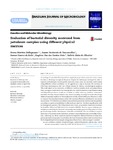Por favor, use este identificador para citar o enlazar este ítem:
http://www.alice.cnptia.embrapa.br/alice/handle/doc/1062180Registro completo de metadatos
| Campo DC | Valor | Lengua/Idioma |
|---|---|---|
| dc.contributor.author | DELLAGNEZZE, B. M. | pt_BR |
| dc.contributor.author | VASCONCELLOS, S. P. de | pt_BR |
| dc.contributor.author | MELO, I. S. de | pt_BR |
| dc.contributor.author | SANTOS NETO, E. V. dos | pt_BR |
| dc.contributor.author | OLIVEIRA, V. M. de | pt_BR |
| dc.date.accessioned | 2017-01-30T11:11:11Z | pt_BR |
| dc.date.available | 2017-01-30T11:11:11Z | pt_BR |
| dc.date.created | 2017-01-30 | pt_BR |
| dc.date.issued | 2016 | pt_BR |
| dc.identifier.citation | Brazilian Journal of Microbiology, São Paulo, v. 47, p. 314-321, 2016. | pt_BR |
| dc.identifier.uri | http://www.alice.cnptia.embrapa.br/alice/handle/doc/1062180 | pt_BR |
| dc.description | Abstract: Unraveling the microbial diversity and its complexity in petroleum reservoir environments has been a challenge throughout the years. Despite the techniques developed in order to improve crude oil, microbial enrichments using different culture conditions can be applied as a way to increase the recovery of DNA from environmentswith low cellular density for further microbiological analyses. This work aimed at the evaluation of different matrices(arenite, shale and polyurethane foam) as support materials for microbial growth and biofilm formation in enrichments using a biodegraded petroleum sample as inoculum in sulfate reducing condition. Subsequent microbial diversity characterization was carried out using Scanning Electronic Microscopy (SEM), Denaturing Gradient Gel Electrophoresis (DGGE) and 16S rRNA gene libraries in order to compare the microbial biomass yield, DNA recovery efficiency and diversity among the enrichments. The DNA from microbial communities in petroleum enrichments was purified according to a protocol established in this work and used for 16S rRNA amplification with bacterial generic primers. The PCR products were cloned, and positive clones were screened by Amplified Ribosomal DNA Restriction Analysis (ARDRA). Sequencing and phylogenetic analyses revealed that the bacterial community was mostly represented by members of the genera Petrotoga, Bacillus, Pseudomonas, Geobacillus and Rahnella. The use of different support materials in the enrichments yielded an increase in microbial biomass and biofilm formation, indicating that these materials may be employed for efficient biomass recovery from petroleum reservoir samples. Nonetheless, the most diverse microbiota were recovered from the biodegraded petroleum sample using polyurethane foam cubes as support material. | pt_BR |
| dc.language.iso | eng | eng |
| dc.rights | openAccess | eng |
| dc.subject | Bacterial diversity | pt_BR |
| dc.subject | Microbial enrichment | pt_BR |
| dc.subject | Petroleum reservoir | pt_BR |
| dc.subject | Physical support | pt_BR |
| dc.subject | 16S rRNA | pt_BR |
| dc.title | Evaluation of bacterial diversity recovered from petroleum samples using different physical matrices. | pt_BR |
| dc.type | Artigo de periódico | pt_BR |
| dc.date.updated | 2017-01-30T11:11:11Z | pt_BR |
| dc.subject.thesagro | Bactéria | pt_BR |
| dc.subject.thesagro | Biodiversidade | pt_BR |
| dc.subject.thesagro | Petróleo | pt_BR |
| dc.subject.thesagro | Biodegradação | pt_BR |
| dc.subject.nalthesaurus | Biodiversity | pt_BR |
| riaa.ainfo.id | 1062180 | pt_BR |
| riaa.ainfo.lastupdate | 2017-01-30 | pt_BR |
| dc.identifier.doi | http://dx.doi.org/10.1016/j.bjm.2016.04.004 | pt_BR |
| dc.contributor.institution | BRUNA MARTINS DELLAGNEZZE, CPQBA; SUSAN PANTAROTO DE VASCONCELLOS, UNIFESP; ITAMAR SOARES DE MELO, CNPMA; EUGENIO VAZ DOS SANTOS NETO, Petrobras; VALERIA MAIA DE OLIVEIRA, CPQBA. | pt_BR |
| Aparece en las colecciones: | Artigo em periódico indexado (CNPMA)  | |
Ficheros en este ítem:
| Fichero | Descripción | Tamaño | Formato | |
|---|---|---|---|---|
| 2016AP35.pdf | 2.68 MB | Adobe PDF |  Visualizar/Abrir |









